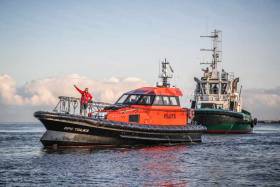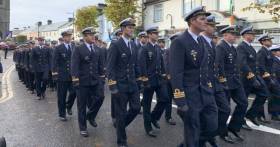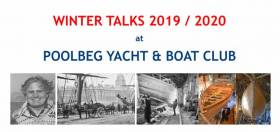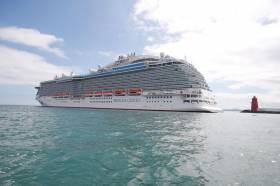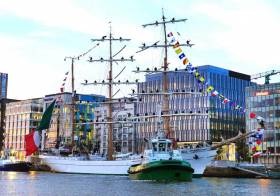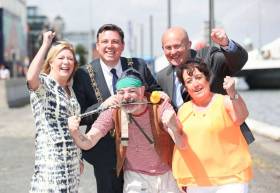Displaying items by tag: Dublin Port
New Pilot Boat Arrives into Dublin Port
Dublin Port Company’s new Pilot Boat named DPC Tolka has arrived into Dublin Port at the weekend.
The state-of-the-art vessel will allow marine pilots to reach and board larger ships in all weather conditions from a greater distance out into Dublin Bay.
As Afloat reported last September, the leading UK boat builder Goodchild Marine Services Limited secured the contract to construct the new Boat.
The new 17.1 metre ORC vessel (originally expected to be delivered in July) is the first Pilot Boat for export by Norfolk-based Goodchild Marine Services Limited.
The boat is renowned for its fuel efficiency, capacity to cut emissions and ability to handle high speeds in bad weather owing to an innovative beak bow design which can steady the hull of the boat as it pitches into the sea.
Piloting the new vessel on her maiden voyage to Dublin was Alan Goodchild of the leading UK boat builder Goodchild Marine Services Limited, the Norfolk-based company that built DPC Tolka having secured the contract to construct the boat in 2018.
Taking delivery in Dublin Port was Harbour Master Captain Michael McKenna and Assistant Harbour Master Tristan Murphy. The new addition to the port’s fleet of working vessels, which includes tug boats Shackleton and Beaufort, multi-purpose workboat the Rosbeg, and pilot boats Liffey and Camac will replace the oldest pilot boat Dodder, which now retires from service after 23 years.
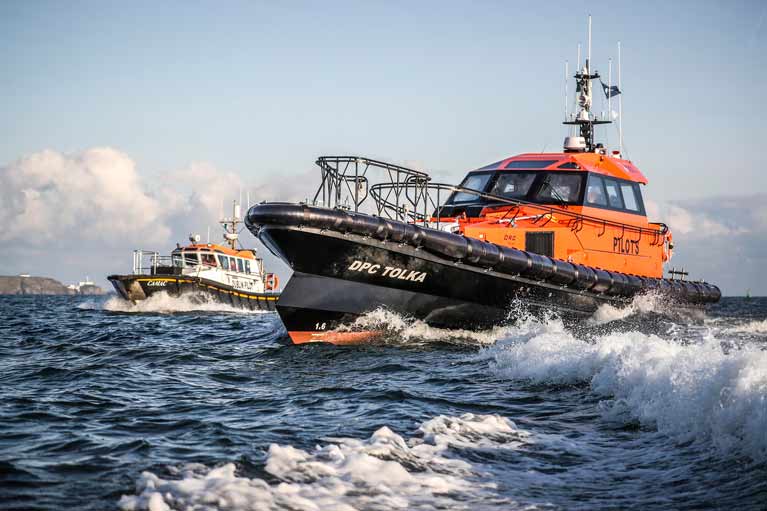
Designed by French Naval Architect Pantocarene for both fuel efficiency and performance in challenging weather conditions, DPC Tolka features the latest navigational and safety equipment on board, including a dedicated Pilot workstation in the wheelhouse and hydraulic Man Overboard Recovery Platform at the stern.
With shipping companies increasingly deploying longer, deeper ships capable of carrying more cargo, DPC Tolka represents a vital upgrade in the provision of pilotage services at the Port and will allow Dublin Port’s team of highly skilled marine pilots to reach and board these ships in all weather conditions from a greater distance out into Dublin Bay.
Dublin Port Harbour Master, Captain Michael McKenna, said: “Dublin Port Company is delighted to take delivery of DPC Tolka, and we’ve already started training our pilots and pilot boat teams on the workings of the new vessel ahead of entering service in the coming weeks. Demand for pilotage continues to grow as more and more ships service Dublin Port, and DPC Tolka will help meet the operational and navigational needs of both regular customers and visiting vessels in the years ahead. Our thanks to the crew at Goodchild Marine for their skills and workmanship in designing and delivering this vessel.”
Eamonn O’Reilly, Chief Executive, Dublin Port Company, said: “Investment in infrastructure is not simply confined to marine engineering works such as building quay walls, but also extends to the fleet that keeps the Port operational around the clock. Our pilots increasingly need to embark and disembark from much larger capacity ships, often in poor weather conditions or at peak times when demands for pilotage services are highest. DPC Tolka has allowed us to upgrade our equipment in line with customer investment in new ships and additional capacity on existing routes.”
Alan Goodchild, Managing Director, Goodchild Marine, said: “Our flagship ORC range of pilot boats are certainly making waves within the industry and we are delighted to be able to export our first ORC 171 to the Dublin Port Company.
“The pilot operation across the UK and Europe now demands bigger and stronger boats that can withstand the most challenging conditions. We believe we have responded to market demand by producing such a vessel.”
Steve Pierce, General Manager, Goodchild Marine said: “It is very important for us to consider the impact that our boats make, both financially and environmentally. Our ORCs are becoming renowned for cutting fuel emissions, with customers reporting fuel savings of up to 40% a year, which we hope is an incentive for both existing and potential clients.”
Officers from Argentinian Navy in Mayo Honour Founder Admiral Brown
Around 200 Argentinian military personnel reports RTE, travelled to Co Mayo to visit the town where the founder of the country's Navy was born.
Admiral William Brown hailed from Foxford and today’s (yesterday) trip was the largest to take place by officers from the Navy he led.
The visiting party was joined by members of the Irish Naval Service for the ceremonies.
The event also attracted many Argentinians living in Ireland, keen to meet up with their compatriots.
The Naval officers attended a memorial mass in the local church before continuing a parade through the town.
As Afloat previously reported the ARA Libertad is the sail training vessel of the Argentinian Navy which visited Dublin Port at the weekend. The five-day visit ends tomorrow afternoon.
More here on the visit to Foxford.
A winter night's gathering in the familiar setting of Poolbeg Yacht & Boat Club in Ringsend in the heart of maritime Dublin can make it seem like summer again for a few magic hours, and this year’s programme, put together by Talks Organiser Darryl Hughes of the classic gaff ketch Maybird, is setting the bar high for his successors.
He has persuaded a varied, entertaining, informative and knowledgeable selection of five speakers to provide four shows, and it starts with renowned local and marine historian Cormac Lowth giving an impressive presentation on Dublin Port on Thursday, November 14th, and concludes with the historic Ilen Project’s Salmons Wake Voyage to West Greenland by Gary MacMahon on Thursday 19th March.
Views of the public, businesses and other interested parties is been sought from Dublin Port Company, on the benefits of investing €108 million in terminal facilities to attract more cruise ships, writes The Irish Times.
The semi-State company (yesterday) launched a public consultation on the future of cruise tourism, seeking opinions on the appetite in the city for his large-scale tourism business, managing the increase in air emissions from additional cruise ships and the financial challenge of funding the proposed new berths.
Economic consultants Indecon estimate the €108 million spent on new berths at the port’s North Wall Quay extension between 2024 and 2026 could generate a net economic benefit of €211 million based on 2019 values.
The port company, however, has said it cannot finance the project itself given its €1 billion plan to build extra capacity to accommodate the projected growth of cargo up to the year 2040.
The proposed new berths would be of limited alternative use outside of cruise ships such as for generating revenue for cargo operations, the company said.
Click here for more on the story.
Cruise Tourism in Dublin Port: Public Consultation Opens
Dublin Port Company (DPC) has launched a public consultation on the future of cruise liner tourism at Dublin Port. To help inform the consultation process, DPC has published a discussion paper setting out key considerations to be addressed. DPC has also published the findings of an independent economic cost-benefit analysis by Indecon International Economic Consultants and recent research by Fáilte Ireland on expenditure by cruise tourists in Dublin.
The consultation, which opens today and runs until 17th January 2020, seeks the views of stakeholders on the future development of cruise tourism in Dublin regarding a number of issues, including:
- The appetite of the City of Dublin for large-scale cruise tourism;
- Environmental considerations, specifically air emissions;
- The financial challenge of funding proposed new cruise berths.
The context for the consultation is Dublin Port’s Alexandra Basin Redevelopment (ABR) Project, which is currently under construction. The final part of this project will involve building new berths suitable for the largest cruise ships at North Wall Quay Extension, east of the Tom Clarke Bridge. Construction is scheduled to start in 2024, meaning the new berths would be available for the cruise season of 2026.
Widespread Support a Prerequisite
DPC is first and foremost looking to ascertain the level of broad-based appropriate support as a prerequisite for the proposed development. The key question being asked of stakeholders, including the general public, is whether Dublin wants to have a large-scale cruise tourism business. If so, then the proposed berths at North Wall Quay Extension are needed.
Air Emissions
Any new berths that might be constructed will have provision for shore power and cruise ships would be required to turn off their engines and use this shore power while at berth. This mandatory requirement is particularly important given the challenge facing the City to address likely imminent breaches of EU air quality limits. DPC wishes to establish the willingness and ability of cruise lines to meet this requirement in Dublin in the future if the new berths are constructed.
Investment Required
The investment required to construct the new berths at North Wall Quay Extension is estimated at €108 million, excluding terminal facilities for cruise turnarounds. Dublin Port Company projects that this investment could treble the number of cruise tourists to 619,000 by 2040, with approximately one-third of these being turnaround passengers who start and finish their cruise in Dublin. By way of context, Dublin Port received some 197,000 cruise tourists in 2018, and approximately one-fifth were turnaround passengers.
Indecon Report
DPC commissioned Indecon International Economic Consultants to evaluate the economic benefit from the proposed investment and from the projected increase in cruise tourism. Indecon’s key finding is that the economic return would be positive. Indecon estimates that the investment of
€108 million (over the years 2024 to 2026) would generate a net economic benefit of €211 million (at 2019 values), equivalent to a benefit to cost ratio of 2.83.
However, the scale of the investment required and the level of risk are such that DPC could not itself finance the project. The company is currently implementing a €1 billion ten-year capital investment programme to deliver additional capacity to cater for projected cargo growth up to 2040. From a development risk perspective, the proposed new berths would be of limited alternative use outside of cruise, i.e. for revenue-generating cargo operations.
Co-Financing Arrangement
Therefore, if the project is to proceed, co-financing is required (as outlined in Masterplan 2020 – Reviewed 2018, Page 33). This could involve a concession agreement with a private sector operator or operators which would provide the €108 million funding up front in exchange for the right to operate the facility for a defined period. Such an approach is provided for in National Ports Policy. Based on the Indecon analysis, DPC is seeking to establish the level of interest among cruise companies and others to support the required investment and arrangement.
Eamonn O’Reilly, Chief Executive, Dublin Port Company, said: “The first part of this consultation asks whether Dublin wants a large cruise tourism business or not. We need to know that there is widespread support and a genuine desire to see cruise tourism on a significantly larger scale than ever before if we are to proceed to build new berths as far upriver as the Tom Clarke Bridge capable of accommodating the largest cruise ships two at a time.
“The second aspect of the consultation looks at how the construction of new cruise berths at
North Wall Quay Extension can be financed. With the Indecon analysis complete, we are clear about the economic benefits of any such investment, but unclear about the industry’s willingness to co-finance future development. This consultation provides an important opportunity to engage and we welcome responses from all stakeholders, national and international, to the process.”
Submissions
Interested parties are invited to respond to the consultation document (available to download at https://www.dublinport.ie/masterplan/cruise-consultation/ no later than 17th January 2020, either by email to [email protected] or by post to:
Cruise Consultation, Dublin Port Company, Port Centre, Alexandra Road, Dublin 1.
Plan for No-Deal in Irish Ports Still Not Tested With Only 37 Days Left
Systems newly designed to avoid chaotic scenes at Irish ports and airports in the event of a no-deal Brexit have not yet been trialled.
With only 37 days until the potential worst-case scenario, the plans reports the Independent.ie, have yet to be road-tested.
Dublin Port has a contingency plan, known as Operation Purge, which is designed to ensure minimum traffic congestion in the city if trucks get delayed by checks.
However, Fianna Fáil Brexit spokesperson Lisa Chambers claims the fact it and other contingency operations have not been trialled "is reckless".
To read more on comments made by Chambers, click here.
Politicians Visit Dublin Port & UK's Largest Energy Port Against Backdrop of Brexit Preparedness
In advance of the UK's prime minister Boris Johnston meeting today in Dublin, it was also reported on RTE News of yesterday's visit by Leo Varakar to Dublin Port where the Taoiseach viewed the €30 million investment that has been put in place to prepare for a possible no-deal Brexit.
While on the other side of the Irish Sea politicians recently paid a visit to the Welsh Port of Milford Haven to view operations at the UK’s largest energy Port.
According to the Milford Haven Port Authority, the Parliamentary Under-Secretary of State for Wales Kevin Foster MP was joined by Stephen Crabb MP and Paul Davies AM for a tour of the Pembrokeshire port located in south-west Wales.
The party were taken on a tour of the Waterway onboard a pilot vessel, hosted by the Port’s Chief Executive Andy Jones, Chairman Chris Martin and Harbourmaster Mike Ryan, where they were able to discuss the Port’s vital role as an important hub of regionally and nationally significant economic activity and employment. Naturally this included topics such as Brexit preparedness and the potential opportunity, post-Brexit, for the Port of Milford Haven to be designated as a Freeport.
As supporters of Pembroke Dock Marine which aims to anchor wave, tidal and floating wind renewable energy developers in Pembrokeshire, the Minister, Stephen and Paul were also keen to hear how that project was progressing as part of the Swansea Bay City Deal.
Andy Jones, Chief Executive at the Port of Milford Haven, discussed the potential impact that 0% import tariffs on petrol will have on UK refineries with the Minister. “Not only is Valero a national asset,” said Andy, “in Pembrokeshire it plays a critical role in supporting an otherwise rural economy and is one of Pembrokeshire’s largest employers. Post Brexit, providing the necessary conditions for continued business investment of businesses like Valero in the face of global competition will be essential in order to secure the viability of the energy cluster here”.
“We welcomed the opportunity to share our thoughts on the idea of Milford Haven being designated as a Freeport and expanded on that idea to develop the concept of a Port Zone” continued Andy. “Port Zones would include accelerated regulatory processes. Prioritising Port Zones would also help reduce investment risk and uncertainty and make the Port a more attractive proposition for potential global investors.”
“The UK Government has a vision for Freeports to boost investment, drive innovation, attract high skill jobs, support free enterprise and drive growth in left-behind areas across the UK,” continued Andy “and while Freeports tend to be associated with general purpose manufacturing and logistics, the Port of Milford Haven’s internationally significant energy sector offers a unique opportunity.”
“As the UK’s leading energy port with its cluster of anchor businesses, excellent grid connectivity and world-class supply chain, the Port of Milford Haven would have a strong competitive advantage attracting relevant investment opportunities were it to be a Freeport. A Freeport designation, aligned with the Haven Waterway Enterprise Zone, would seek to support UK oil and gas refining and processing capacity as it competes for global foreign direct investment, restore fish processing capability and support tidal and wave energy development to name a few of the potential opportunities.”
UK Government Minister for Wales Kevin Foster said: “It is fantastic to see the Port of Milford Haven developing plans for a world class centre for marine energy, attracting inward investment and creating more highly skilled jobs. I look forward to working closely with the Port and Welsh Government to develop this project as part of the Swansea Bay City Deal, generating transformational growth across the region.”
Mexican Tall Ship Arrives in Dublin
Dublin Port Company and the Mexican Embassy in Dublin have welcomed one of the world’s largest Tall Ships, the 270-foot-long Cuauhtémoc, which sailed into Dublin early this morning for a five-day visit to the capital. She is berthed at Sir John Rogerson’s Quay for the duration of her stay, and open to the public to visit, free of charge, on the following dates and times:
- Friday, 6th September, from 11.00am to 8.00pm
- Saturday 7th September, from 11.00am to 8.00pm
- Sunday 8th September, from 11.00am to 8.00pm
- Monday 9th September, from 11.00am to 8.00pm
Having arrived from Hamburg, Dublin is the second-last stop on the ship’s 250-day training voyage of Northern Europe involving visits to 15 ports in 10 different countries (Canada, United Kingdom, France, Netherlands, Denmark, Norway, Germany, Ireland, Spain and Colombia).
Led by Commanding Officer Captain Carlos Gorraez Meraz, the Cuauhtémoc is an official sail training vessel of the Mexican Navy which travels around the world carrying a message of friendship and goodwill. This is the Cuauhtémoc’s fifth visit to Irish waters since her maiden call in 1998. She subsequently visited the capital in 2008, in 2012 as part of the Tall Ships festival and again in 2015.
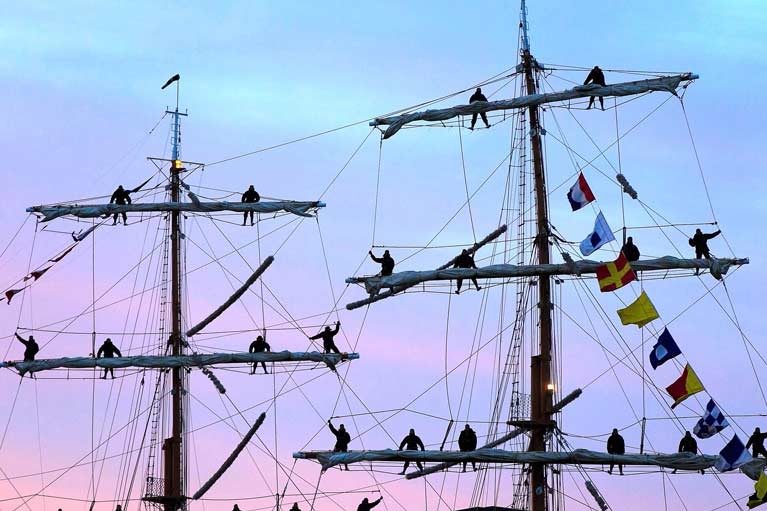 The Mexican tall ship opens to the public to visit, free of charge, from Friday 6th to Monday 9th September at Sir John Rogerson’s Quay (11am to 8pm daily). Photo: Shane O'Neill
The Mexican tall ship opens to the public to visit, free of charge, from Friday 6th to Monday 9th September at Sir John Rogerson’s Quay (11am to 8pm daily). Photo: Shane O'Neill
Members of the public visiting the ship this weekend will be able to get a closer insight into life on board for the 257-strong crew and inspect the fine craftsmanship of the vessel which has trained more than thirty generations of officers, cadets, petty officers and sailors, both Mexican and other nationalities.
Commenting on the tall ship’s visit, The Ambassador of Mexico to Ireland, H.E. Miguel Malfavón said; “For over 40 years, Mexico has enjoyed excellent diplomatic relations with Ireland built on a shared sense of history and strengthening cultural, academic and trading ties in the present day. The arrival of the Cuauhtémoc reminds us of the affinity and friendship that exists between our two nations and symbolises the hand of friendship from Mexico to Ireland. For most of the crew on board, this is their first visit to Ireland, marking a new generation of Mexican-Irish exchange.”
Encouraging members of the public to visit over the weekend, Eamonn O’Reilly, Chief Executive, Dublin Port Company, said; “Tall Ship visits to Dublin are always a highlight and the Cuauhtémoc is no exception. This is a spectacular vessel and one of the finest working tall ships at sea today. I would encourage people in the city to take a trip down to Sir John Rogerson’s Quay to explore the Cuauhtémoc over the weekend and show her a warm Irish welcome during her stay. She brings a little piece of Mexico to our doorstep and it’s an opportunity not to be missed.”
Built in the Celaya shipyards in Bilbao, Spain, the Cuauhtémoc was launched in July 1982. She was the last of four windjammers built by Bilbao shipyards and is named after the last Aztec Emperor who was imprisoned and executed by the conquistador, Hernán Cortés, in 1525. This is her fifth visit to Irish waters.
Europort: Is Rosslare Ready for Brexit?
The WexfordPeople writes, following his visit to Wexford to officially open the M11 Gorey to Enniscorthy bypass, pictures were circulated of a smiling Taoiseach Leo Varadkar meeting with representatives at Rosslare Europort.
Having shed his tie after a long day, there were smiles nonetheless as he was shown around the Port which he's publicly stated as being key to post-Brexit Ireland.
However, decades of neglect means getting things up to code is a mammoth task, particularly with a Brexit deadline of October looming large. With a €320million expansion plan being outlined for Dublin Port, critics have accused the government of merely paying lip-service to Rosslare and are not holding out too much hope that it will get the shot in the arm it needs.
General Manager at the port Glenn Carr, however, remains firm that Brexit should represent an opportunity for Rosslare.
More on the story can be read through this link.
South Docks Festival in Dublin Celebrates Community
This month's South Docks Festival in Dublin is celebrating community and heritage and taking pride in the identity inherent in the South Dublin Docklands area.
This year’s festival is run by staff and volunteers at St. Andrew’s Resource Centre in collaboration with local communities around Pearse Street, Westland Row and City Quay.
More on the festival here


























